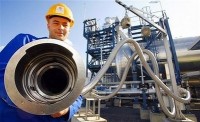By Anthony Watts, Watts Up With That
I’ve always thought that the biggest issue with greens was not CO2 and AGW, but “progress in general”. This story seems to support that notion. Maybe they’ll get James Hansen to denounce it too. - Anthony
‘Emissions-free’ coal plant pilot fires up in Germany
BERLIN (AFP) – One of Europe’s biggest power companies inaugurates on Tuesday a pilot project using a technology that it is presenting as a huge potential breakthrough in the fight against climate change. But green campaigners have denounced the project as a cosmetic operation that does not really address the problem of global warming.
At the site of the massive “Schwarze Pumpe” ("Black Pump") power station in the old East Germany, Vattenfall wants to the new method to allow it continue burning coal - but with radically reduced emissions. To do so, the Swedish firm is using Carbon Capture and Storage, or CCS for short, which captures the greenhouse gases produced when fossil fuels are combusted.
The captured gases are then sharply compressed until they become liquid and are injected deep underground, sealed away and therefore will not contribute to the increase in the Earth’s temperature, Vattenfall says.

With around two-thirds of the world’s power generated by burning fossil fuels and humanity set to rely heavily on these “for the foreseeable future,” Vattenfall says the new technology is the way forward. “CCS will work as a temporary solution that buys us the time we need to develop a sustainable energy system in the future. We say that CCS is a way of ‘bridging to the future’,” according to Vattenfall’s website.
“This represents an important milestone in our efforts to radically reduce our own carbon dioxide emissions and develop technology to reduce emissions on a global basis.” The firm has invited around 400 guests to participate in Tuesday’s grand inauguration, including representatives from both the Swedish and German governments.
But environment groups are far from happy. Germany’s BUND pressure group for instance slammed CCS as a mere “fig leaf” allowing companies and governments to continue building new coal-fired power stations while giving the appearance of caring about global warming. “Vattenfall managers talk a lot about supposedly environmentally friendly coal power stations but they are still planning and building conventional coal-fired power stations with high levels of CO2 emissions,” BUND’s energy spokesman Thorben Becker said.
Read more here.
By Michael Asher, Daily Tech
Alarm over sea ice loss is misplaced. Recent short-term gains in Arctic ice coverage indicate nothing about the eventual state of the Arctic. Answers to the long-term status of the region lie in the realm of a scientific branch known as paleoclimatology. What does it tell us?
The Earth is currently in the geologic epoch known as the Holocene. This began nearly 12,000 years ago when the last ice age (more precisely, the Weichsal glacial) ended. Temperatures warmed, glaciers began to retreat, and the Arctic began to melt. This began what is called an interglacial: a warmer period between glaciation. We tend to think of the poles as immutable, but geologically speaking, permanent polar ice is a rare phenomenon, comprising less than 10% of history. Icecaps form briefly between interglacials, only to melt as the next one begins—this time around will be no different.
So we know the Arctic will eventually be open water. The only question is how it will affect us? No change in sea level.
Arctic ice, which floats rather than being anchored on bedrock, doesn’t influence sea levels at all. Antarctica and Greenland do, but with one on a long-term cooling trend, and the other melting at the infinitesimal pace of 0.25% per century, there doesn’t seem to be any call for alarm. Sea level has been rising for thousands of years; the increase over the next century is expected to be less than 1/3 meter.
“Unimaginable” amounts of new resources: What’s at stake is nothing less than millions of square miles of territory, with some of the richest resources known. 90 billion barrels of oil and 1,700 trillion cubic feet of natural gas lie in the region. An ice-free Arctic also means access to other mineral resources, and access to rich new fishing grounds. Analysts have hesitated to put a figure on the total worth. But that’s not all. Just the ability to safely navigate the region is itself valuable.
The Northwest and Northeast Passages: First navigated in 1905, the famed Northwest Passage allows ships to cross between the Pacific and Atlantic oceans. Currently this requires a trip through the Panama Canal, a lengthy, expensive voyage that is barred to the largest “post-Panamax” class of ships. The permanent opening of the Northwest Passage will shave thousands of miles off each crossing, saving millions of barrels of diesel fuel annually, boosting trade and cutting shipment costs for a wide variety of imported and exported goods.
Nearly as important, the Northeast Passage is vital for parts of Northern Europe and Russia. First navigated as far back as 1879, a permanent opening will not only reduce shipping costs between Russia and Northern Europe, it will be a boon for thousands of tiny coastal communities that are currently cut off from the outside world for most of each year. Though the benefits are unmistakable, a certain segment of the population argues we shouldn’t use them. They believe using the planet’s resources is immoral, even obscene. But the fact remains that these resources are not just valuable; they’re vital. The still-growing populations of China and India are now clamoring for access to the same standard of living the western world enjoys. Granting it to them will require new sources of food, energy, and raw materials. Russia has already put its foot in the door, claiming some 460,000 square miles of new territory—an area larger than France and Germany combined. With its fleet of nuclear-powered icebreakers already surveying, Russia is brushing aside objections over its cavalier acts.
One fact remains without doubt. The warming of the Arctic will not result in our own extinction, or be anything at all but a tremendous boon to mankind and our civilization. Don’t let anyone tell you otherwise. Read more here.
By Paul Dreissen, CORE
The US Minerals Management Service recently announced that it intends to prepare a new Five Year Leasing Plan for the Outer Continental Shelf. This is a vital first step in initiating more exploration and production on OCS lands that MMS estimates could hold 86 billion barrels of oil and 420 trillion cubic feet of natural gas.
MMS has opened the process for taking public comments. I’m writing to you, in hope that you will take a few minutes form your hectic day to write a brief note or letter to MMS, underscoring your support for leasing these lands and producing more of the oil and gas that are the foundation for our economy, living standards and opportunities.
Already, a number of environmental pressure groups have mobilized their extensive financial and networking resources, to deluge MMS with comments OPPOSING any plan that opens up more OCS acreage for leasing and drilling. I’ve heard that comments to MMS are currently running at approximately 15 to 1 AGAINST opening new OCS areas - and thus in favor of continuing the unconscionable Energy War on Poor Families.
To make it easier for you to write a letter to MMS, I’ve attached a sample letter that provides some facts and ideas you can use, and that you can tailor to your own taste. Also attached are a couple of background papers by MMS and the National Ocean Industries Association (NOIA) that provide useful information about the OCS program and the laws and technologies that enable us to extract even more energy, from even deeper waters, with even greater care for the environmental values we all cherish.
You can send a detailed letter like this. But even a brief letter supporting a full analysis and expanded leasing program will help greatly. All comment letters must REACH MMS by SEPTEMBER 15, when the comment period closes.
Letters can be snail-mailed to the addresses on the sample MMS letter - or they can be submitted by going to the MMS website (http://www.mms.gov/5-year/5-YearProgramComments.htm) and using either of the following links: via the web: Public Commenting System via e-mail: 5YearRFIComments@mms.gov Thank you for tackling this, and supporting expanded US energy production, in the midst of everything else you are doing.
See sample letter here.


